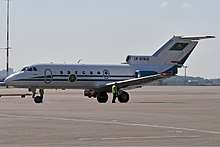Yakovlev Yak-40
The Yakovlev Yak-40 (Russian: Яковлев Як-40; NATO reporting name: Codling) is a small, three-engined jet airliner, the world's first commuter trijet. The maiden flight was made in 1966, and it was in production from 1967 to 1981. Introduced in September 1968, the Yak-40 has been exported since 1970.
| Yak-40 | |
|---|---|
 | |
| Volga-Dnepr Yak-40 | |
| Role | Regional jet/ VIP transport |
| National origin | Soviet Union |
| Manufacturer | Yakovlev |
| First flight | October 21, 1966 |
| Introduction | September 1968 (Aeroflot) |
| Status | In service |
| Primary users | Motor Sich Airlines [1] Severstal Air Company [2] Vologda Aviation Enterprise[3] Aeroflot (former) |
| Produced | 1967–1981 |
| Number built | 1,011 (according to some sources, 1,013) |
| Unit cost |
US$1M (1972)[4] |
Development
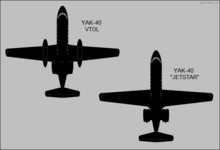
By the early 1960s, Soviet international and internal trunk routes were served by Aeroflot, the state airline, using jet or turboprop powered airliners, but their local services, many of which operated from grass airfields, were served by obsolete piston-engine aircraft such as the Ilyushin Il-12, Il-14 and Lisunov Li-2.[5] Aeroflot wanted to replace these elderly airliners with a turbine-powered aircraft, with the Yakovlev design bureau being assigned to design it. High speed was not required, but it would have to be able to operate safely and reliably out of poorly equipped airports with short (less than 700 m or 2,300 ft) unpaved runways in poor weather.[6]
Yakovlev studied both turboprop and jet-powered designs to meet the requirement, including Vertical Take-Off and Landing designs with lift jets in the fuselage or in wing-mounted pods, but eventually they settled on a straight-winged tri-jet carrying 20 to 25 passengers. The engines were to be the new AI-25 turbofan being developed by Ivchenko at Zaporozhye in Ukraine.[7]
Design
.jpg)
.jpg)
The Yak-40 is a low-winged cantilever monoplane with unswept wings, a large T-tail and a retractable tricycle landing gear. The passenger cabin is ahead of the wing, with the short rear fuselage carrying the three turbofan engines, with two engines mounted on short pylons on the side of the fuselage and a third engine in the rear fuselage, with air fed from a dorsal air-intake by an "S-duct", as is an auxiliary power unit, fitted to allow engine start-up without ground support on primitive airfields.[8][9] The three AI-25 engines are two-shaft engines rated at 14.7 kN (3,300 lbf). The engines have no jetpipes, and initially no thrust reversers.[10][11]
The pressurized fuselage has a diameter of 2.4 metres (94 in). Pilot and co-pilot sit side-by-side in the aircraft's flight deck, while the passenger cabin has a standard layout seating 24 to 27 passengers three-abreast, although 32 passengers can be carried by switching to four-abreast seating. Passengers enter the aircraft via a set of ventral airstairs in the rear fuselage.[11][12]
The wing is fitted with large trailing-edge slotted flaps, but has no other high-lift devices, relying on the aircraft's low wing loading to give the required short-field take-off and landing performance. The wings join at the aircraft centerline, with the main spar running from wingtip to wingtip The wings house integral fuel tanks with a capacity of 3,800 litres (1,000 US gal; 840 imp gal). The aircraft has a large fin, which is swept back at an angle of 50 degrees to move the tailplane rearwards to compensate for the short rear fuselage. The horizontal tailplane itself is unswept.[9][13]
The Yak-40 was the first Soviet-built airliner designed to Western airworthiness requirements.[14]
Operational history
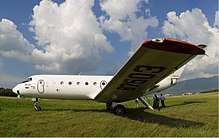
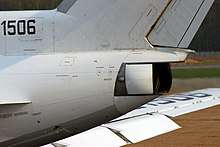
The first of five prototypes made its maiden flight on 21 October 1966,[11] with production being launched at the Saratov Aviation Plant in 1967 and Soviet type certification granted in 1968.[9] The type carried out its first passenger service for Aeroflot on 30 September 1968.[13] In the 1972 version, a tailspin was removed. In 1974, new version was introduced, with non-stop flight distance increased. Also, the forward door on the right side of the fuselage changed its place – it was located together with the sixth window.
In 1975, the last upgrade of Yak-40 took place – the number of cabin windows on the right side changed from nine to eight.
By the time production ended in November 1981, the factory at Saratov had produced 1,011 or 1,013 aircraft. By 1993 Yak-40s operated by Aeroflot had carried 354 million passengers.[15] As well as being the backbone of Aeroflot's local operations, flying to 276 domestic destinations in 1980, the Yak-40 was also an export success. In addition to this, Yak-40 became the first Russian/Soviet aircraft to get flying certificates from Italy and West Germany. It was demonstrated in 75 countries of the world, including the US, where orders for the Yak-40 were made.
A total of 130 were exported to Afghanistan, Angola, Bulgaria, Cambodia, Cuba, Czechoslovakia, Equatorial Guinea, Ethiopia, Germany, Guatemala, Honduras, Hungary, Italy, Laos, Madagascar, Philippines, Poland, Syria, Vietnam, Yugoslavia and Zambia.[9][15]
Variants
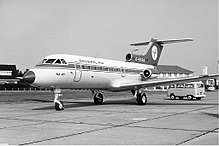

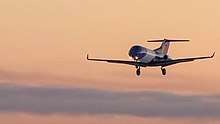
Data from:- OKB Yakovlev[16]
- Yak-40 – The first production model.
- Yak-40-25 Military conversion with the nose of a MiG-25R and SRS-4A Elint installation.
- Yak-40 Akva (Aqua) – Military conversion with nose probe, pylon-mounted sensors, a fuselage dispenser and underwing active jammer pods.
- Yak-40D (Dal'niy – long-distance) – with non-stop flight distance enlarged.
- Yak-40EC – Export version.
- Yak-40 Fobos (Phobos) – Military conversion with two dorsal viewing domes and a removable window on each side.
- Yak-40K – cargo / convertible / combi version with a large freight door. Produced in 1975–81.
- Yak-40 Kalibrovshchik – Military Elint conversion with a "farm" of blade, dipole and planar antennas.
- Yak-40L – Proposed version with two Lycoming LF507-1N turbofans, a joint program between Skorost and Textron (now Allied-Signal) Lycoming. The original design would have had a slightly swept wing.
- Yak-40 Liros – Military conversion with nose probe carrying air-data sensors.
- Yak-40M – Proposed 40-seat stretched passenger version.
- Yak-40 M-602 – Flying testbed with a Czechoslovak M 602 turboprop installed in the nose.
- Yak-40 Meteo – Military conversion with multipole dipole antennas and fuselage dispenser.
- Yak-40P – Yak-40L with large nacelles projecting ahead of the wings.
- Yak-40REO – Military conversion with large ventral canoe for IR linescan. Lateral observation blister on right side.
- Yak-40 Shtorm – Military conversion with multiple probes and sensors on the forward sidewalls.
- Yak-40TL – Proposed upgraded version, to be powered by three Lycoming LF 507 turbofan engines.
- Yak-40V – Export version powered by three AI-25T turbofan engines.
- Yak-40MS – Experimental upgrade with two Honeywell TFE731-5 turbofan engines by SibNIA.[17]
- STR-40DT – A proposed fully composite derivative along the line of TVS-2DTS, also being developed by SibNIA. Endorsed, but not supported by Yakovlev.[18]
Operators

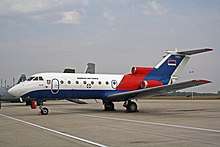



Civilian operators
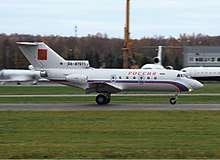
As of July 2019, a total of 22 out of 1011 Yakovlev Yak-40 aircraft remained in service with civil operators.[19] The airworthiness of several Yak-40 of smaller Russian and Central Asian charter airlines is uncertain, as is the whereabouts of one Air Libya Tibesti aircraft after the civil war. Most aircraft in service today have been reconfigured for VIP-charter services, with fewer than ten remaining in scheduled passenger service. Known operators are:[20]
- Ariana Afghan Airlines – former operator
- Bakhtar Afghan Airlines – former operator
- Ada Air – former operator
- TAAG Angola Airlines – former operator
- Azerbaijan Airlines – former operator
- Government of Belarus
- Aerosur – former operator
- Balkan Bulgarian Airlines – former operator
- Hemus Air – former operator
- Aerocaribbean – former operator
- Cubana – former operator
- Government of the Czech Republic – former operator
- CSA Czechoslovak Airlines – former operator
- Government of Czechoslovakia – former operator
- Slov-Air – former operator
- EgyptAir – former operator
- General Air – former operator
- Olympic Airways[21] – former operator
- Mayan World Airlines – former operator
- Rollins Air – former operator
- Malév – former operator
- Aertirrena – former operator
- Alinord – former operator
- Avianova – former operator
- Avioligure – former operator
- Cabado – former operator
- Air Kazakhstan
- Air Kokshetau – former operator
- Bek Air – former operator
- East Kazakhstan Region Air Enterprise – 2 in cargo configuration
- Euro-Asia Air – former operator
- Semeyavia – former operator
- Tulpar Air Service – former operator
- Zhetysu Aviakompania – 2: one for charter and one in cargo configuration
- Zhezkazgan Air – 2 in scheduled service
- Kyrgyzstan Airlines – former operator
- Air Libya Tibesti – former operator
- Air Lithuania – former operator
- Air Moldova – former operator
- Expreso Aéreo – former operator
- Servicios Aéreos Amazónicos – former operator
- Interisland Airlines – former operator
- LOT Polish Airlines – former operator
- 2nd Sverdlovsk Air Enterprise – former operator
- AeroBratsk – former operator
- Aerolik – former operator[22]
- Ak Bars Aero – former operator
- Amur Airlines – former operator
- Aviakompaniya SKOL – former operator
- Aviastar – former operator[22]
- Belgorod Air Enterprise – former operator
- Bugulma Air Enterprise – former operator
- Byline – former operator
- Center-South Airlines – former operator
- Gazpromavia – former operator
- Khabarovsk Airlines – former operator
- LUKoil-Avia – former operator
- Orel Avia – former operator[23]
- Petropavlovsk-Kamchatsky Air Enterprise – 3 with 2 in cargo configuration and 1 in scheduled passenger service
- Rossiya – former operator
- RusAir – former operator
- Severstal Air Company – former operator
- Tomskavia – former operator
- Tulpar Air – former operator
- UTair Aviation – former operator
- Vladivostok Avia – former operator (phased out in 2013)
- Volga-Dnepr – former operator
- Vologda Aviation Enterprise – 8 in scheduled passenger service
- Yak Service – former operator
- Yakutia Airlines – former operator
- Yamal Airlines – former operator
- Yuzhmashavia – former operator
- Government of Slovakia – former operator
- Aeroflot – former operator
- Syrian Arab Airlines – former operator
- Tajikistan Airlines – former operator
- Turkmenistan Airlines – former operator
- Motor Sich Airlines
- Aerostar Airlines – former operator
- Constanta Airlines – 1 in lounge configuration, for charter only
- Challenge Aero – former operator
- Uzbekistan Airways – former operator
- Oriental de Aviación – former operator
- Vietnam Airlines – former operator
Military operators
As of November 2012 no more than 17 Yak-40 remain in military service (possibly fewer, with the unclear situation in Syria). Known operators are:
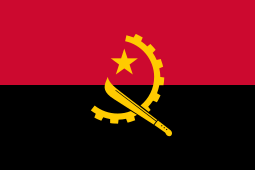
- Angolan Air Force – 1 as of December 2016.[24]

- Bulgarian Air Force – former operator

- Cuban Air Force – 3 in service

- Czechoslovakian Air Force – former operator

- Czech Air Force – 1 as of December 2016.[25]
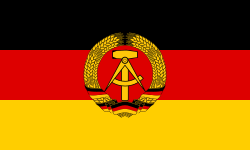
- East German Air Force – former operator
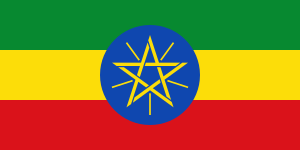
- Ethiopian Air Force – 1 in service

- Military of Equatorial Guinea – presidential aircraft
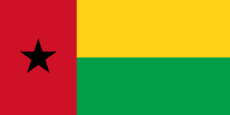
- Guinea-Bissau Air Force – former operator

- Hungarian Air Force – former operator
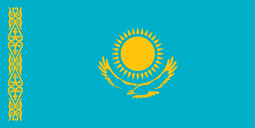
- Armed Forces of the Republic of Kazakhstan – 1 in service
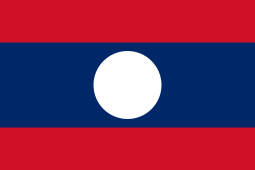
- Lao People's Liberation Army Air Force – former operator

- Lithuanian Air Force – former operator
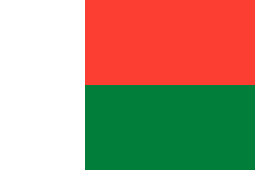
- Military of Madagascar – 2 in service

- Polish Air Force – former operator

- Russian Air Force – 1 in service

- Serbian Air Force – former operator

- Syrian Air Force – up to 6 in service, airworthiness unclear

- Soviet Air Force – former operator

- Vietnam People's Air Force – former operator
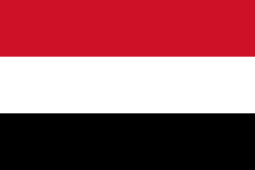
- Yemen Air Force – 2 in service
.svg.png)
- Yugoslav Air Force – former operator
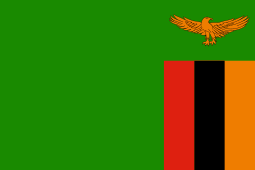
- Zambian Air Force – former operator
Accidents and incidents
The Yak-40 suffered 122 accidents and incidents for a total of 842 fatalities.[26]
- On September 3, 1970, Aeroflot Flight W-4, a Yak-40 (CCCP-87690), struck the side of Mount Airy-Tash, 56 mi northeast of Leninabad (now Khujand), Tajik SSR at 2,100 m (6,890 ft) due to pilot error, killing all 21 on board.[27][28]
- On May 4, 1972, Aeroflot Flight 608, a Yak-40 (CCCP-87778), crashed while on approach to Bratsk Airport after a loss of control caused by windshear, killing all 18 on board.[29][30]
- On February 28, 1973, Aeroflot Flight X-167, a Yak-40 (CCCP-87602), fell back onto the runway at Semipalatinsk Airport during takeoff due to crew error, killing all 32 on board.[31][32]
- On August 8, 1973, Aeroflot Flight A-547, a Yak-40 (CCCP-87790), ran off the runway on takeoff from Arkhangelsk Airport after the elevators locked up due to an electrical problem, killing the co-pilot.[33]
- On November 2, 1973, an Aeroflot Yak-40 was hijacked by four people who demanded money and to be taken to Sweden; the plane was stormed on the ground at Moscow and the hijackers arrested. Two people died.[34]
- On May 2, 1974, Aeroflot Flight 1255, a Yak-40 (CCCP-87398), ran off the runway at Rostov Airport following an aborted takeoff, killing one of 38 on board.[35][36]
- On May 23, 1974, Aeroflot Flight N-166, a Yak-40 (CCCP-87579), crashed near Kiev due to possible crew incapacitation, killing all 29 on board.[37]
- On December 14, 1974, Aeroflot Flight 124, a Yak-40 (CCCP-87630), overran the runway at Bukhara Airport following an aborted takeoff due to a locked elevator, killing seven of 19 on board.[38][39]
- On July 15, 1975, Aeroflot Flight E-15, a Yak-40 (CCCP-87415) struck Mount Mtirala, Caucasus Mountains, during a go-around at Chorokh Airport in poor weather, killing all 41 on board.[40]
- On August 15, 1975, Aeroflot Flight A-53, a Yak-40 (CCCP-87323), entered a downdraft and nearly stalled and subsequently crashed on approach to Krasnovodsk Airport due to pilot error and unfavourable weather conditions, killing 23 of 28 on board in Turkmenistan's worst-ever accident.[41][42]
- On October 22, 1975, Aeroflot Flight L-98, a Yak-40 (CCCP-87458), crashed near Novgorod Airport. Visibility was poor at Novgorod due to fog, but this was not forecast to the crew. A straight-in approach was attempted, but the aircraft went off course after passing the outer marker. The descent continued until the landing gear and wing struck a building and later crashed into an apartment building and a car, killing all six on board and five on the ground.[43][44]
- On March 19, 1976, a Syrian Arab Airlines Yak-40S2 (YK-AQC) was hit by a RPG during boarding at Beirut International Airport; Lebanese Prime Minister Rashid Karam had just boarded the aircraft, but he survived the attack.[45]
- On September 9, 1976, Aeroflot Flight 31, a Yak-40 (CCCP-87772) from Rostov Airport to Kerch Airport, collided in mid-air with Aeroflot Flight 7957, an Antonov An-24 (CCCP-46518), over the Black Sea 37 km (23 mi) off Anapa due to violation of separation rules, the error of both aircraft crews and probably ground ATC. All 18 occupants of the Yak-40 and 46 people on board the An-24 died.
- On December 17, 1976, an Aeroflot Yak-40 (CCCP-88208) crashed shortly after takeoff from Ust-Kut Airport due to crew errors, killing all seven on board.[46]
- On March 30, 1977, Aeroflot Flight N-925, a Yak-40 (CCCP-87738), crashed on approach to Zhdanov Airport in poor visibility after descending too low, killing eight of 28 on board.[47][48]
- On October 7, 1978, Aeroflot Flight 1080, a Yak-40 (CCCP-87437), crashed on climbout from Koltsovo Airport following engine failure caused by icing, killing all 38 on board.
- On November 16, 1979, an Aeroflot Yak-40 (CCCP-87454) was being ferried from Velikiy Ustlug to Vologda as Flight 564 when it crashed at Vologda Airport after descending too low, killing three of the five crew.[49][50]
- On February 3, 1980, a Cubana Yak-40 (CU-T1219) crashed on landing at Baracoa Airport, killing one of 37 on board.[51]
- On June 8, 1980, a TAAG Angola Airlines Yak-40K (D2-TYC) crashed near Matala, Angola, killing all 19 on board; the aircraft was probably shot down by a Zambian Shenyang J-6.[52]
- On June 12, 1980, Aeroflot Flight W-88, a Yak-40 (CCCP-87689), struck the slope of a mountain 44 km (27 mi) northwest of Dushanbe Airport due to navigational errors by the crew while attempting to avoid bad weather, killing all 29 on board.[53][54][55]
- On August 29, 1981, Aeroflot Flight 674, a Yak-40 (CCCP-87346), crashed at Zeya, Russia while on approach after descending too low, killing three of 34 on board.[56][57]
- On September 18, 1981, Aeroflot Flight V-652, a Yak-40 (CCCP-87455) from Irkutsk Airport to Ilimskiy Airport, collided in mid-air with an Aeroflot Mi-8 helicopter (CCCP-22268) on a training flight while approaching its destination airport. The supposed site of the collision occurred in the clouds. All 33 on board the Yak-40 and seven occupants of the Mi-8 were killed, making it the third deadliest Yak-40 incident at the time.[58][59][60]
- On April 19, 1983, Aeroflot Flight E-46, a Yak-40 (CCCP-87291), struck a mountain 26 mi from Leninakan Airport after the crew deviated from the flight route and later descended too low, killing all 21 on board.[61][62]
- On October 11, 1985, Aeroflot Flight G-7, a Yak-40 (CCCP-87803), struck a mountain side 29 mi west of Kutaisi in poor weather while climbing to 2,400 m (7,900 ft) from 300 m (980 ft), killing all 14 on board. The accident was attributed to ATC errors.[63][64]
- On May 17, 1986, an Aeroflot Yak-40 (CCCP-87928) crashed in the Ob River floodplain (11 mi from Khanty-Mansiysk Airport) after a wing separated during a test flight, killing all five on board. The aircraft was being test-flown following repairs from an incident on April 18, 1986.[65]
- On January 16, 1987, Aeroflot Flight 505, a Yak-40, crashed on takeoff from Yuzhny Airport after encountering a wake vortex from an Ilyushin Il-76 that had taken off a minute before, killing all nine on board.
- On June 19, 1987, Aeroflot Flight N-528, a Yak-40 (CCCP-87826), overran the runway on landing at Berdyansk Airport following an aborted go-around in heavy rain and a tailwind, killing eight of 29 on board.
- On January 24, 1988, Aeroflot Flight 29674, a Yak-40 (CCCP-87549), experienced failure of number 1 and 3 engines during take-off from Nizhnevartovsk Airport. Engine number 2 also experienced some problems, but recovered while engines one and three eventually failed. The plane stalled, crashed and broke up, killing 27 of 31 on board. Cause was possible crew error.[66][67][68]
- On August 2, 1988, at Sofia Airport, a Hemus Air Yak-40 LZ-DOK crashed on take-off. All civil traffic had been halted minutes before because of the departure of the Bulgarian leader Todor Zhivkov's Tupolev Tu-154. After the delay, air traffic control cleared LZ-DOK for take-off to Varna, asking the crew to expedite their departure. Trying to leave in a hurry, the crew did not set the trim correctly and began their take-off run from the middle of the 3000 m runway. The aircraft failed to become airborne, overran the runway into a ravine and caught fire, killing 29 of 37 on board. The "black box" of the airplane was never found.
- On August 1, 1990, Aeroflot Flight E-35D, a Yak-40 (CCCP-87453) traveling from Zvartnots Airport, Armenian SSR to Stepanakert Airport struck a mountain 22 km (14 mi) away from its destination killing all 46 on board. The cause was probably pilot error (premature descent).[69][70]
- On November 7, 1991, Yugavia Flight S-519, a Yak-40 (CCCP-87526), struck Kukurtbash Mountain (14 mi north-northwest of Makhachkala Airport) in poor visibility, killing all 51 on board; the aircraft was overloaded and was designed to carry 32 passengers, not 47.[71][72]
- On March 27, 1992, another aircraft from Aeroflot Armenia (registration unknown) with 30 passengers and four crew, on an evacuation mission from Stepanakert to Yerevan, was hit after take-off by a MANPADS (reported by a source to be an SA-7) launched by Azeri forces. The missiles damaged one of the plane's engines and —there are conflicting reports— either forced the pilots to land at Sisian (on Armenian-controlled territory) or made it to Yerevan.[73][74][75]
- On May 9, 1992, a third Aeroflot Armenia aircraft (CCCP-87532) on evacuation mission from Stepanakert to Yerevan with 30 passengers (refugees and wounded) and three crew, was attacked above Kalbajar District (a now Armenian-occupied part of Azerbaijan) by gunfire from an Azeri Sukhoi Su-25 flown by Vagif (or Vaghit) Kurbanov, an Azeri pilot that had defected with his aircraft a month earlier from Russian forces stationed at Sitalchay. The crew managed to make a gear up land at Sisian airfield. Everyone survived but the plane was written off.[75][76][77]
- On November 14, 1992, Vietnam Airlines Flight 474 with 31 passengers and crew flying from Ho Chi Minh City-Tan Son Nhat International Airport to the previously civilian Nha Trang Airport impacted obstacles on approach killing all but one passenger. Adverse weather conditions might have been involved (unclear at investigation).
- On August 28, 1993, a Tajik Air Yak-40 (87995) operating a non-scheduled flight that was grossly overloaded with 81 passengers and five crew members overran the runway on takeoff at Khorog Airport and crashed into the Panj River. The crew were killed and only four passengers survived. The crew may have been forced to overload the aircraft. This is the deadliest accident involving a Yak-40 as well as the deadliest accident in Tajikistan.
- On February 25, 1994, a Yak-40 (OB-1559) operated by Expreso Aéreo, piloted by two Russians and one Peruvian,[78] struck Mount Carpish six minutes after leaving Tingo María, Peru for Lima. The 31 occupants were killed.[79]
- On September 26, 1994, a Cheremshanka Airlines Yak-40 (RA-87468) from Krasnoyarsk Airport, Russia to Tura was unable to land at Tura because of bad weather so was diverted to Vanavara. It ran out of fuel due to crew and ATC errors and crashed while attempting an emergency landing on a river, 41 km (25 mi) from Vanavara. All 28 passengers and crew were killed.[80]
- On October 27, 1994, Rostov Air Enterprise (Donavia) Flight 156, a Yak-40 (RA-88254) was hijacked on October 25 while en route to Rostov from Ashgabad by one man claiming to have a bomb. After reporting the incident the pilot returned to Makhachkala. The hijacker demanded 2 million US dollars and to be flown to Iran. The aircraft landed and some passengers were released, but more hostages were not released until the next afternoon on October 26. By that evening all passengers were released, leaving the hijacker and some of the crew on board. Shortly after midnight on October 27, they too were released. Just before sunrise, as the aircraft was about to be stormed by security forces, the hijacker blew himself up with a homemade bomb. The blast damaged the plane, and it was written off.[81]
- On November 5, 1994, another Peruvian aircraft (OB-1569) belonging to Amazonic regional airline Servicios Aéreos Amazónicos, that was serving the Trujillo-Saposoa-Juanjuí-Tocache-Lima schedule, crashed into the Saposoa River after overrunning the airstrip during landing. The aircraft either crashed due to heavy rain reported at the time. From the 31 occupants (26 passengers and 5 crew) 5 passengers and 1 crewmen died.[82][83][84]
- In 1996, two Weasua Air Transport Yak-40s (RA-87290 and RA-87999) were destroyed on the ground at Sprigg Payne Airport after being struck by RPG-7 anti-tank rockets during the First Liberian Civil War.[85][86]
- On 19 February 1997, a Semeyavia Yakovlev Yak-40 overshot the runway on landing at Semey Airport, Kazakhstan following a scheduled domestic passenger flight. There were no fatalities among the 14 passengers and four crew members on board, but the aircraft was damaged beyond repair.[87]
- On May 15, 1997, an Azerbaijan Airlines Yak-40 (4K-87504) crashed near Gyandzha Airport during a training flight, killing all six on board. Stray small-arms fire from Azerbaijani soldiers on the ground struck an oxygen cylinder on the Yak-40, starting a fire. Control was lost and the aircraft crashed.[88]
- On October 29, 1997, an Ariana Afghan Airlines Yak-40 (YA-KAE) crashed on landing at Jalalabad Airport, killing one.[89]
- On May 25, 1998, a Lao Aviation Yak-40 (RDPL-34001) crashed in a jungle near Long Tieng, Xiangkhouang in heavy rain, killing all 26 on board.[90]
- On August 26, 1999, an Uzbekistan Airways Yak-40 (UK-87848) struck power lines during its second approach to Turtkul Airport; the aircraft landed wheels-up and slid for nearly 500 feet before it hit an embankment, killing two of 33 on board.[91]
- On March 9, 2000, Vologda Air Flight 9651, a Yak-40 (RA-88170), stalled and crashed shortly after takeoff from Sheremetyevo Airport due to wing icing and crew error, killing all nine on board. The aircraft was operating a charter flight to Kiev for Aeroteks.[92][93]
- In 2000, an Ecuato Gunieana de Aviacion Yak-40 (RA-87847) was written off after its tail was hit by a taxiing Swissair MD-11 at Santa Isabel Airport. The aircraft was leased from NovgorodAvia; the accident occurred sometime after July 2000.[94]
- On May 17, 2001, a Faraz Qeshm Airlines flight departed Tehran heading for Gorgan Airport carrying 30 people, including the Iranian Transport Minister Rahman Dadman, two deputy ministers and seven more members of parliament was forced to divert due to bad weather conditions and was later discovered crashed into the Elburz mountains, Iran. All on board perished.[95][96]
- On January 13, 2004, Uzbekistan Airways Flight 1154, a Yak-40 (UK-87985) from Termez Airport to Tashkent International Airport carrying 37 passengers and crew, crashed; the crew failed to descend for approach on time. Finding the runway too short to land, a go-around was attempted but failed. The plane touched down beyond the end of the runway and the left wing struck a concrete building, with the subsequent crash and fire killing all on board.[97]
- On March 17, 2011, two Air Libya Yak-40s (5A-DKG, 5A-DKM) along with an Air Libya Boeing 737 were written off following attacks at Benina International Airport during the First Libyan Civil War.
- On May 26, 2014, a Constanta Yak-40 (UR-MMK) was damaged while parked at Donetsk Airport during the First Battle of Donetsk Airport and burned out.[98]
- On February 18, 2015, a BPV Group Yak-40 (UR-MIG) was struck by an out-of-control Antonov An-26B (EW-246TG) that was performing an engine test at Boryspil Airport.[99]
- On July 9, 2018, an AeroBratsk Yak-40 (RA-87397) overran the runway on landing at Aldan Airport; the aircraft suffered minor damage and all 25 on board were uninjured.
Specifications (Yak-40)
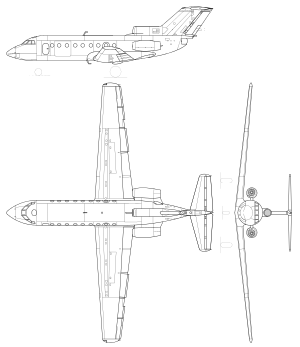
Data from Jane's All The World's Aircraft 1976–77[11]
General characteristics
- Crew: 3 (two pilots, one flight mechanic)
- Capacity: 32 passengers
- Length: 20.36 m (66 ft 10 in)
- Wingspan: 25.0 m (82 ft 0 in)
- Height: 6.50 m (21 ft 4 in)
- Wing area: 70.00 m2 (753.5 sq ft)
- Aspect ratio: 9:1
- Empty weight: 9,400 kg (20,723 lb)
- Max takeoff weight: 15,500 kg (34,172 lb)
- Fuel capacity: 3,910 L (860 imp gal; 1,030 US gal)
- Powerplant: 3 × Ivchenko AI-25 turbofan engines, 14.7 kN (3,300 lbf) thrust each
Performance
- Maximum speed: Mach 0.7 (IAS)
- Cruise speed: 550 km/h (340 mph, 300 kn) at 7,000 m (23,000 ft) (max. cruise)
- Range: 1,800 km (1,100 mi, 970 nmi)
- Service ceiling: 8,000 m (26,000 ft) [100]
- Rate of climb: 8.00 m/s (1,575 ft/min)

See also
Related development
Aircraft of comparable role, configuration and era
- Fokker F28
- Fokker 70
- VFW-Fokker 614
Related lists
References
- "Motor Sich Airlines - Fleet". flymotorsich.com. Retrieved February 6, 2019.
- "Severstal Air Company - The Airfleet". severstal-avia.ru. Retrieved February 6, 2019.
- "Вологда, аэропорт - Авиапарк". avia35.ru (in Russian). Retrieved February 6, 2019.
- "Airliner price index". Flight International. 10 August 1972. p. 183.
- Stroud 1968, p. 269–270.
- Gunston and Gordon 1997, p. 185.
- Gunston and Gordon 1997, pp. 185–186.
- Stroud 1968, p. 270–272.
- Gordon Komissarov and Komissarov 2005, p. 303
- Gunston and Gordon 1997, p. 187.
- Taylor 1976, pp. 448–449.
- Stroud 1968, pp. 272–273.
- Gunston and Gordon 1997, pp. 186–187.
- https://www.flightglobal.com/pdfarchive/view/1975/1975%20-%200140.html
- Gunston and Gordon 1997, p. 189.
- Gordon, Yefim; Dmitry; Sergey Komissarov (2005). OKB Yakovlev. Hinkley: Midland Publishing. pp. 303–311. ISBN 1-85780-203-9.
- "Новосибирские инженеры подняли в воздух самолет, который станет современным аналогом Як-40". tass.ru.
- "Опытный образец цельнокомпозитного самолёта СТР-40ДТ покажут в конце года - Авиация России". aviation21.ru.
- Thisdell and Seymour Flight International 30 July–5 August 2019, p. 47.
- "World Airline Census 2018". Flightglobal.com. Retrieved 2018-08-26.
- 1972 original route network: https://www.routesonline.com/news/38/airlineroute/257185/1972-olympic-airways-network/
- Ottenhof, 1996, p. 418
- Ottenhof, 1996, p.419
- Hoyle Flight International 6–12 December 2016, p. 26.
- Hoyle Flight International 6–12 December 2016, pp. 33–34.
- "Yakovlev Yak-40". Aviation Safety Network. Retrieved 22 August 2018.
- Accident description for CCCP-87690 at the Aviation Safety Network. Retrieved on 2015-08-13.
- "Катастрофа Як-40 Таджикского УГА в районе Ленинабада" [Accident Yak-40 Leninabad] (in Russian). airdisaster.ru. Retrieved 2015-08-13.
- "ASN Aircraft Accident Yakovlev 40 CCCP-87778 Bratsk Airport (BTK)". Aviation Safety Network. Retrieved 2012-10-09.
- "Yak-40, c/n 9040314". Dutch Aviation Society Soviet Transport Database. Retrieved 5 April 2018.
- "ASN Aircraft Accident Yakovlev 40 CCCP-87602 Semipalatinsk Airport (PLX)". Aviation Safety Network. Retrieved 2012-10-09.
- "Катастрофа Як-40 Казахского УГА близ аэропорта Семипалатинска" [Accident Yak-40 Semipalatinsk Airport] (in Russian). airdisaster.ru. Retrieved 2015-08-13.
- Accident description for CCCP-87790 at the Aviation Safety Network
- Hijacking description at the Aviation Safety Network
- Accident description for CCCP-87398 at the Aviation Safety Network
- "Катастрофа Як-40 Липецкого ОАО в а/п Ростов-на-Дону" [Accident Yak-40 Rostov-on-Don Airport] (in Russian). airdisaster.ru. Retrieved 2018-08-20.
- "Катастрофа Як-40 Украинского УГА близ Киева" [Accident Yak-40 Kiev] (in Russian). airdisaster.ru. Retrieved 2015-08-13.
- Accident description for CCCP-87630 at the Aviation Safety Network
- "Катастрофа Як-40 Таджикского УГА в а/п Бухара" [Accident Yak-40 Bukhara Airport] (in Russian). airdisaster.ru. Retrieved 2018-08-20.
- "ASN Aircraft Accident Yakovlev 40 CCCP-87475 Batumi-Chorokh Airport (BUS)". Aviation Safety Network. Retrieved 2012-10-09.
- "ASN Aircraft Accident Yakovlev 40 CCCP-87323 Krasnovodsk Airport (KRW)". Aviation Safety Network. Retrieved 2012-10-09.
- "Катастрофа Як-40 Азербайджанского УГА близ Красноводска" [Accident Yak-40 near Krasnovodsk] (in Russian). airdisaster.ru. Retrieved 2015-08-13.
- Accident description for CCCP-87458 at the Aviation Safety Network. Retrieved on 2016-06-08.
- "Катастрофа Як-40 Латвийского УГА в Новгороде" [Accident Yak-40 Novgorod] (in Russian). airdisaster.ru. Retrieved 2018-08-23.
- Criminal description for YK-AQC at the Aviation Safety Network. Retrieved on 2018-08-20.
- Accident description for CCCP-88208 at the Aviation Safety Network. Retrieved on 2018-08-20.
- Accident description for CCCP-87738 at the Aviation Safety Network. Retrieved on 2018-08-20.
- "Катастрофа Як-40 Украинского УГА близ Жданова" [Accident Yak-40 near Zhdanov] (in Russian). airdisaster.ru. Retrieved 2018-08-20.
- Accident description for CCCP-87454 at the Aviation Safety Network. Retrieved on 2018-08-20.
- "Катастрофа Як-40 Ленинградского УГА близ а/п Вологда" [Accident Yak-40 near Vologda Airport] (in Russian). airdisaster.ru. Retrieved 2018-08-23.
- Accident description for CU-T1219 at the Aviation Safety Network. Retrieved on 2018-08-20.
- "ASN Aircraft Accident Yakovlev 40K DT-TYC Matala". Aviation Safety Network. Retrieved 2012-10-09.
- "ASN Aircraft Accident Yakovlev 40 CCCP87689 Dushanbe". Aviation Safety Network. Retrieved 2012-10-09.
- "Катастрофа Як-40 Таджикского РПО ГА близ Душанбе" [Accident Yak-40 near Dushanbe] (in Russian). airdisaster.ru. Retrieved 2015-08-13.
- "Yak-40, c/n 9940103". Dutch Aviation Society Soviet Transport Database. Retrieved 5 April 2018.
- Accident description for CCCP-87346 at the Aviation Safety Network. Retrieved on 2018-08-20.
- "Катастрофа Як-40 Дальневосточного УГА в районе а/п Зея" [Accident Yak-40 in the Zeya Airport region] (in Russian). airdisaster.ru. Retrieved 2018-08-23.
- "ASN Aircraft Accident Yakovlev 40 CCCP-87455 Zheleznogorsk-Ilimskiy". Aviation Safety Network. Retrieved 2012-10-09.
- "Столкновение Як-40 и Ми-8 ВС УГА в районе г.Железногорск-Илимский" [Mid-air collision of Yak-40 and Mi-8 near Zeleznogorsk-Ilimskiy] (in Russian). airdisaster.ru. Retrieved 2015-08-13.
- "Yak-40, c/n 9431236". Dutch Aviation Society Soviet Transports Database. Retrieved 5 April 2018.
- Accident description for CCCP-87291 at the Aviation Safety Network. Retrieved on 2018-08-20.
- "Катастрофа Як-40 Армянского УГА близ Ленинакана" [Accident Yak-40 near Leninakan] (in Russian). airdisaster.ru. Retrieved 2018-08-23.
- Accident description for CCCP-87803 at the Aviation Safety Network. Retrieved on 2018-08-20.
- "Катастрофа Як-40 Грузинского УГА близ Миха-Цхакая (Сенаки)" [Accident Yak-40 near Mikha-Tskhakaya (Senaki)] (in Russian). airdisaster.ru. Retrieved 2018-08-23.
- Accident description for CCCP-87928 at the Aviation Safety Network. Retrieved on 2018-08-20.
- "ASN Aircraft Accident Yakovlev 40 CCCP-87549 Nizhnevartovsk Airport (NJC)". Aviation Safety Network. Retrieved 2012-10-09.
- "Катастрофа Як-40 Приволжского УГА в районе Нижневартовска" [Accident Yak-40 near Nizhnevartovsk] (in Russian). airdisaster.ru. Retrieved 2015-08-13.
- "Yak-40, c/n 9531442". Dutch Aviation Society Soviet Transport Database. Retrieved 5 April 2018.
- "ASN Aircraft Accident Yakovlev 40 CCCP-87433 Stepanakert". Aviation Safety Network. Retrieved 2012-10-09.
- "Катастрофа Як-40 Армянского УГА близ Степанакерта" [Accident Yak-40 near Stepanakert] (in Russian). airdisaster.ru. Retrieved 2015-08-13.
- Accident description for CCCP-87526 at the Aviation Safety Network. Retrieved on 2018-08-20.
- "Катастрофа Як-40 Элистинского ОАО авиаконцерна Югавиа близ Махачкалы" [Accident Yugavia Yak-40 near Makhachkala] (in Russian). airdisaster.ru. Retrieved 2018-08-23.
- Ranter, Harro. "ASN Aircraft accident Yakovlev 40 registration unknown Stepanakert". aviation-safety.net. Retrieved 5 April 2018.
- https://fas.org/asmp/campaigns/MANPADS/foia/Terroristtactics-make%20sure%20not%20classified!!.pdf p.72-73
- "CIS region - Авиация в локальных конфликтах - www.skywar.ru". www.skywar.ru. Retrieved 5 April 2018.
- Ranter, Harro. "ASN Aircraft accident Yakovlev 40 CCCP-87532 Sisian Airport". aviation-safety.net. Retrieved 5 April 2018.
- Mladenov, Alexander (2015). Su-25 'Frogfoot' Units In Combat. p. 60.
- "Peru Tragedia Aérea". El Tiempo.com. 1994-02-27. Retrieved 2013-04-15.
- "ASN Aircraft Accident Yakovlev OB-1559 Tingo Maria". Aviation Safety Network. Retrieved 2012-10-09.
- "ASN Aircraft Accident Yakovlev 40 RA-87468 Vanavara". Aviation Safety Network. Retrieved 2012-10-09.
- Hijacking description for RA-88254 at the Aviation Safety Network. Retrieved on 2018-08-20.
- Ranter, Harro. "ASN Aircraft accident Yakovlev 40 OB-1569 Saposoa Airport (SQU)". aviation-safety.net. Retrieved 5 April 2018.
- "Archived copy". Archived from the original on 2015-09-23. Retrieved 2013-10-13.CS1 maint: archived copy as title (link)
- "Plane Crashes in Peruvian Jungle; At Least 20 Injured". www.apnewsarchive.com. Retrieved 5 April 2018.
- Hull-loss description for RA-87290 at the Aviation Safety Network. Retrieved on 2018-08-22.
- Hull-loss description for RA-87999 at the Aviation Safety Network. Retrieved on 2018-08-22.
- "ASN Aircraft Accident Yakovlev 40 UN-87233 Semipalatinsk Airport (PLX)". Aviation Safety Network. Retrieved 2012-10-09.
- Accident description for 4K-87504 at the Aviation Safety Network. Retrieved on 2016-06-08.
- Accident description for YA-KAE at the Aviation Safety Network. Retrieved on 2018-08-22.
- Accident description for RDPL-34001 at the Aviation Safety Network. Retrieved on 2018-08-20.
- Accident description for UK-87848 at the Aviation Safety Network. Retrieved on 2018-08-20.
- Accident description for RA-88170 at the Aviation Safety Network. Retrieved on 2018-08-22.
- "Катастрофа Як-40 Вологодского АП в Шереметьево. А.Боровик" [Accident Vologda Air Yak-40 Sheremetyevo] (in Russian). airdisaster.ru. Retrieved 2018-08-22.
- Hull-loss description for RA-87847 at the Aviation Safety Network. Retrieved on 2018-08-22.
- "ASN Aircraft Accident Yakovlev 40 EP-TQP Sari". Aviation Safety Network. Retrieved 2012-10-09.
- "Yak-40, c/n 9740856". Dutch Aviation Society Soviet Transport Database. Retrieved 5 April 2018.
- "ASN Aircraft Accident Yakovlev 40 UK-87985 Tashkent Airport (TAS)". Aviation Safety Network. Retrieved 2012-10-09.
- Criminal description for UR-MMK at the Aviation Safety Network. Retrieved on 2018-08-23.
- Non hull-loss description for UR-MIG at the Aviation Safety Network. Retrieved on 2018-08-23.
- Gunston 1995, p. 492.
Bibliography
- Gordon, Yefim, Dmitry Komissarov and Sergey Komissarov. OKB Yakovlev: A History of the Design Bureau and its Aircraft. Hinkley, UK: Midland Publishing, 2005. ISBN 1-85780-203-9.
- Gunston, Bill. The Osprey Encyclopedia of Russian Aircraft 1875–1995. London:Osprey, 1995. ISBN 1-85532-405-9.
- Gunston, Bill and Yefim Gordon. Yakovlev Aircraft since 1924. London, UK: Putnam Aeronautical Books, 1997. ISBN 1-55750-978-6.
- Hoyle, Craig. "World Air Forces Directory". Flight International. Vol. 190, No. 5566, 6–12 December 2016, pp. 22–53. ISSN 0015-3710.
- Ottenhof, Guus; Hillman, Peter and Jessup, Stuart. Soviet Transports. Aviation Hobby World. 1996. ISBN 0-907178-60-X.
- Stroud, John. Soviet Transport Aircraft since 1945. London:Putnam, 1968. ISBN 0-370-00126-5.
- Thisdell, Dan and Seymour, Chris. "World Airliner Census". Flight International, Vol. 196, No. 5694, 30 July–5 August 2019. ISSN 0015-3710. pp. 24–47.
- Taylor, John W. R. Jane's All The World's Aircraft 1976–77. London:Jane's Yearbooks, 1976. ISBN 0-354-00538-3.
External links
| Wikimedia Commons has media related to Yakovlev Yak-40. |
- List of all Yak-40 aircraft used by Polish Air Force
- Watch a video of the plane in action
- Walkaround Yak-40 (Kiev's Aviation Museum, Ukraine)
- "Passenger aircraft : Yak-40". Yakovlev Design Bureau.
- *"The Yak-40". Flight International. 11 May 1967.

